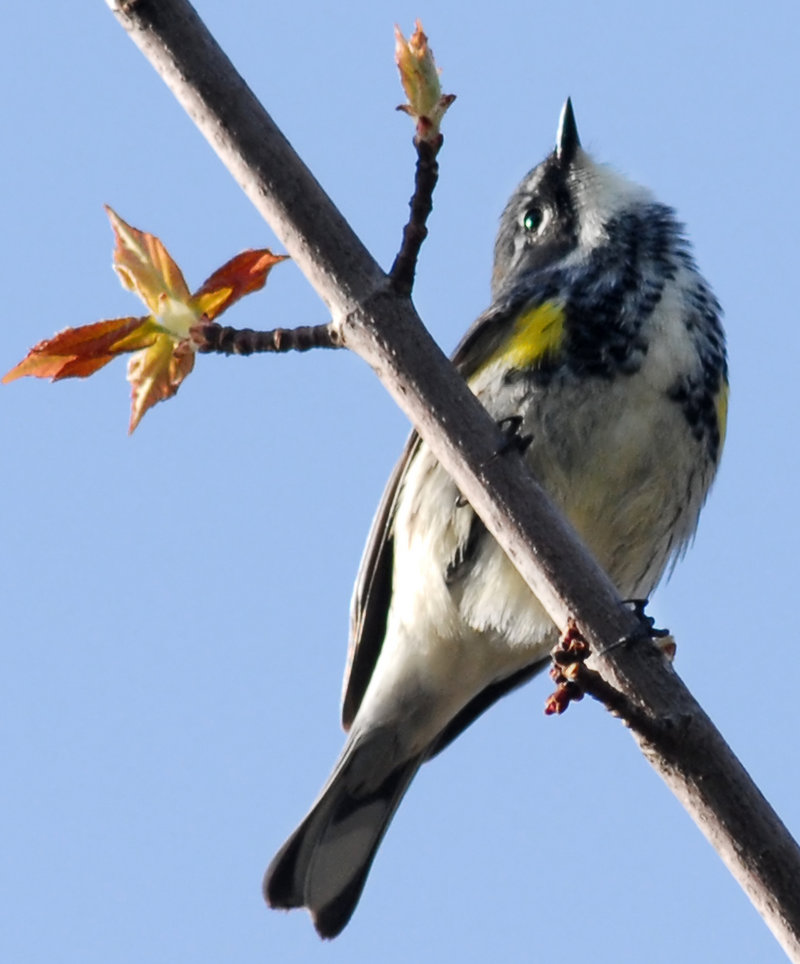The past couple of weeks have been exciting ones for the fall landbird migration. In today’s column, I will describe a recent field trip to make a couple of points about the nature of the autumnal migration.
October 3 was a rainy, windy day. Realizing the promise of productive coastal birding, Luke Seitz, one of the top birders in the state, decided to check out coastal sites in southern Maine. What a day he had! Along with the expected warblers and sparrows, here are exceptional sightings made by Seitz at Cape Neddick and Fort Foster: 11 Yellow-billed Cuckoos, seven White-eyed Vireos, one Yellow-throated Vireos, a Worm-eating Warbler, two Blue-winged Warblers, four Hooded Warblers, two Connecticut Warblers, one Yellow-breasted Chat, a Summer Tanager and a Blue Grosbeak. You can see some of Seitz’s photographs of these birds at http://tinyurl.com/6jvjm5h.
The phenomenon that Seitz experienced is called a fallout. Inclement weather forces migrating birds to abort their evening’s journey and seek shelter. It’s likely that many of these birds were flying westward off the shore to find cover. Of course, Seitz knew that the weather conditions were favorable for a coastal fallout of migrants, and his hunch was proven correct. So, windy, rainy days can often be the best times to go birding in the fall.
So why were the birds listed above exceptional sightings for Maine? Yellow-billed Cuckoos are uncommon nesting birds in southern Maine, so seeing 11 in one day is remarkable. Yellow-throated Vireos and Yellow-breasted Chats are uncommon breeders in southern Maine. Both of these species are much more abundant south of Maine, all the way down to Florida on the Eastern Seaboard. Blue-winged Warblers are uncommon breeders in southern Maine and are most common in the mid-Atlantic states to the Midwest.
The remaining species do not nest in Maine. The northern limit of the breeding range is southern New England for White-eyed Vireos and Worm-eating Warblers. Hooded Warblers reach southeastern New York and New Jersey. Summer Tanagers and Blue Grosbeaks reach their northern breeding limits in southern Pennsylvania.
Furthermore, all of these species winter south of North America. Most migrate to Caribbean Islands or Central America for the winter. Some Summer Tanagers go all the way to South America.
What in the world are these migrants doing in Maine in October? Shouldn’t they be well on their way south to tropical areas?
The explanation is a phenomenon that ornithologists call reverse migration (or reverse orientation). Young geese, swans and other large birds migrate in flocks. Young birds can learn the migratory route from experienced older birds that have made the trip before.
However, perching birds do not migrate in cohesive flocks. These birds have their migratory route genetically programmed. In most cases, a juvenile bird is able to find its way to a wintering area where it has never been. A neat trick!
In some cases, however, birds become disoriented by 180 degrees and hence embark on a northbound trip in the fall when they should be heading south. Most birds that undertake these reverse migrations are inexperienced juvenile birds. So for those of us in northern areas, reverse migration in the fall affords us the best chance to see migratory perching birds that are normally found well to our south.
Some extralimital birds seen in Maine may have arrived here by an orientation error different from a 180-degree angle. For instance, a Smith’s Longspur (the second record for Maine) was found in Norridgewock in late September. Smith’s Longspurs breed in the arctic tundra of Alaska and Canada and winter in Oklahoma and adjacent states. The Norridgewock bird must have taken a southern migration route about 45 degrees to the southeast of its proper route to find itself in Maine.
Herb Wilson teaches ornithology and other biology courses at Colby College. He welcomes reader comments and questions at: whwilson@colby.edu
Send questions/comments to the editors.



Success. Please wait for the page to reload. If the page does not reload within 5 seconds, please refresh the page.
Enter your email and password to access comments.
Hi, to comment on stories you must . This profile is in addition to your subscription and website login.
Already have a commenting profile? .
Invalid username/password.
Please check your email to confirm and complete your registration.
Only subscribers are eligible to post comments. Please subscribe or login first for digital access. Here’s why.
Use the form below to reset your password. When you've submitted your account email, we will send an email with a reset code.